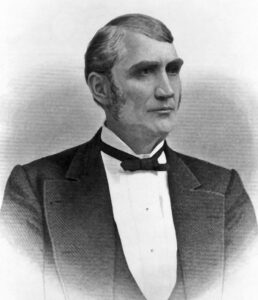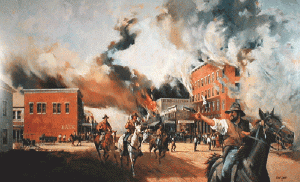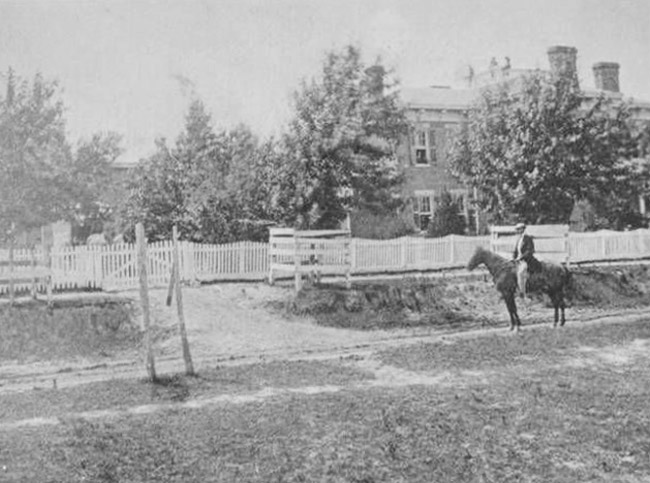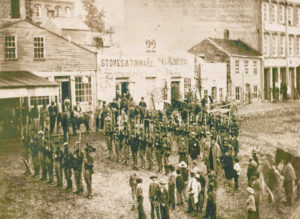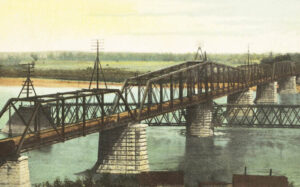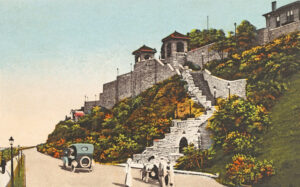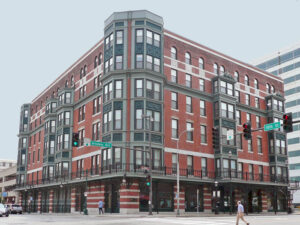Colonel Kersey Coates was a Kansas City, Missouri businessman who developed Quality Hill, founded the Kansas City Board of Trade and was among those who attracted the Hannibal & St. Joseph Railroad to the city.
During his life, his name was so well known, and his western life so closely identified with the growth and prosperity of Kansas City that they have become part and parcel of her history.
Kersey Coates was born in Sadsbury, Pennsylvania, on September 15, 1823, to Lindley and Deborah S. Simmons Coates, life-long members of the Society of Friends. His father was a farmer, but deeming his son’s talents adapted to a more intellectual life, he gave him the advantages of a liberal education, and the young man attended school, first near home and afterward at Whitestown Seminary in New York, completing his course at Phillips Academy, in Andover, Massachusetts.
In these institutions, he became proficient in several of the modern languages. After finishing his studies, he was appointed to the chair of English literature in the high school in Lancaster, Pennsylvania, where he taught the youth of his native county for several years until he qualified to study law. When he was about 25 years old, he entered the office of the late distinguished lawyer, politician, and statesman, Honorable Thaddeus Stevens, an associate and personal friend of his father, with whom he remained until 1853 when he was admitted to the bar.
At about this time, the “irrepressible conflict between the pro-slavery and the anti-slavery parties was approaching its culmination, and the Kansas-Nebraska Act was agitating the entire country. Colonies from the North and the South were formed and sent into these territories, especially the latter, to possess and hold them in the interest of one party. Leaving his home in Pennsylvania in 1854, Coates moved to Kansas City, Missouri, to attend to real estate interests. He soon found himself living among desperate men from Missouri, Kentucky, Virginia, and Georgia, who were determined to make Kansas a slave State.
Armed forces traversed the prairies of Bleeding Kansas, and murders were so frequent that finally, the United States government sent its troops to interfere between the belligerent parties. Imbued with the principles of liberty, Coates took a position with the Free-State faction not long after, and for two years, he remained on the border. In exercising his inherent freedom of speech, he constantly became a target of hatred from pro-slavery elements. In the meantime, the Free-State party praised his great personal fearlessness, his devotion to the cause of human rights, his legal skill and attainments, and his clear, calm head as a tower of strength. He was looked up to as a powerful and safe man and was employed as one of the counsels for the defense of Kansas Governor Charles Robinson when that official was on trial for treason.
His experiences were of the most daring and startling character. Having seen Kansas virtually through her trouble, he purchased land on the bluffs above the Missouri River on Quality Hill to develop an upscale neighborhood. In 1855, he married Sarah Walter Chandler, a Quaker from Pennsylvania who had come to the area with her family a year earlier. They had four children.
Kansas City began to show signs of business life and activity in 1856-57; Colonel Coates was one of those far-sighted and intelligent citizens who used every possible means to build up the country’s resources and his adopted home. With his assistance and those of other enterprising citizens, newspapers were established, railroads were planned, favorable legislation was achieved, grand commercial enterprises were established, necessary municipal improvements were initiated, and a correspondence system with prominent eastern newspapers was established, which resulted in an immigration wave that quickly filled Kansas City and overflowed into neighboring Missouri and Kansas counties. Colonel Coates engaged in various activities before the Civil War, such as banking, real estate, merchandising, and construction. In addition, he secured legislative and municipal aid for the Missouri Pacific and Cameron Railroads.
In 1859, the couple built a beautiful brick home on the outskirts of Kansas City at 10th and Pennsylvania in the “Quality Hill” subdivision he established. The neighborhood on one of the highest bluffs overlooking the West Bottoms became the place for the elite, especially those who shared their beliefs.
In politics, Colonel Coates was always a firm and steadfast Republican. During the political contest of 1860, he was bold and outspoken in his views and was president of the only Republican club in Western Missouri, if not the only one west of St. Louis.
During the Civil War, Kersey enlisted in the Missouri Home Guard in the 77th Regiment. Before the war closed, he was made colonel and commanded a regiment, which at different times during 1863-65 rendered valuable and efficient service and was especially useful during the “Price’s Raid” of 1864.
At the close of the war, Colonel Coates devoted his time and attention to rebuilding the city, which had lost nearly half its population during the previous four years. At that time, no railroad had reached the limits of Kansas City, nor was there one closer than 30 miles. By the war’s end, Leavenworth, Kansas, the old rival of Kansas City, had prospered, had a population of 15,000, and embraced the metropolitan lifestyle.
Undaunted, Colonel Coates and his associates began where they had left off in 1860, aroused a new interest of Eastern capitalists in the various railroad lines projected before the war, and almost before the people of Leavenworth were aware of it, had renewed the contract with the Hannibal and St. Joseph Railroad Company for building the Cameron branch of that road. They also procured the charter for a bridge over the Missouri River at Kansas City and induced a wealthy corporation to undertake the construction of it; they had incorporated the Missouri River, Fort Scott, and Gulf Railroad, obtained for it a splendid endowment of land from the State of Kansas, and effected a treaty between the government and various tribes of the Indian nation, giving the company significant advantages.
Colonel Coates and his co-laborers had concentrated commercial facilities of every kind. Working with New York and Boston investors’ wealth and moneyed influence in Kansas City, the population had increased by over 600% within five years after the war. He was mainly instrumental in securing the legislation in Congress and the Kansas Legislature, which resulted in the Missouri River and Fort Scott Railroad, of which he was president for several years. Besides his handsome residence, he erected the elegant Coates House hotel and the Coates Opera House, one of the finest theatres in the West. He was one of the organizers of the Kansas City Industrial Exposition and Agricultural Fair Association in 1870. When the Inter-State Fair Association was organized in 1882, he was elected its president and held the position most of the time until his death.
During his last years, he was happily able to relax his attention to business and focused on public charities. He also wholly or partially supported many pensioners and disbursed considerable sums to private charities. Local enterprises to advance the city’s welfare found in him a shrewd promoter and steadfast friend.
Kersey Coates died at his home in Kansas City on April 24, 1887. At his funeral, civic leaders served as pallbearers, and a group of black men asked to carry his casket to honor Coates’ anti-slavery leadership.
In 1892, the city wanted to clean up the area around what once was Kersey Coates’ premier neighborhood, Quality Hill. Under the leadership of George Kessler, West Terrace Park was created at 8th and Jefferson Street and the scenic drive below it was named Kersey Coates Drive.
Sarah Coates lived in their stately home until she died in 1897.
“He always expected great things from Kansas City… I never had the faith in the town he had.”
— Sarah Coates, before she died in 1897
The Kersey mansion and Coates Opera House are gone today, but his Quality Hill neighborhood lives on as a tribute to this pioneer. Also gone is Kersey Coates Drive, which was condemned to build the Southwest Trafficway and Interstate I-35 in the 1950s.
©Kathy Alexander/Legends of America, updated January 2024.
Also See:
Sources:
Case, Theodore S.; History of Kansas City Missouri, D. Mason & Co.; Syracuse, New York, 1888.
KCHistory
Wikipedia

